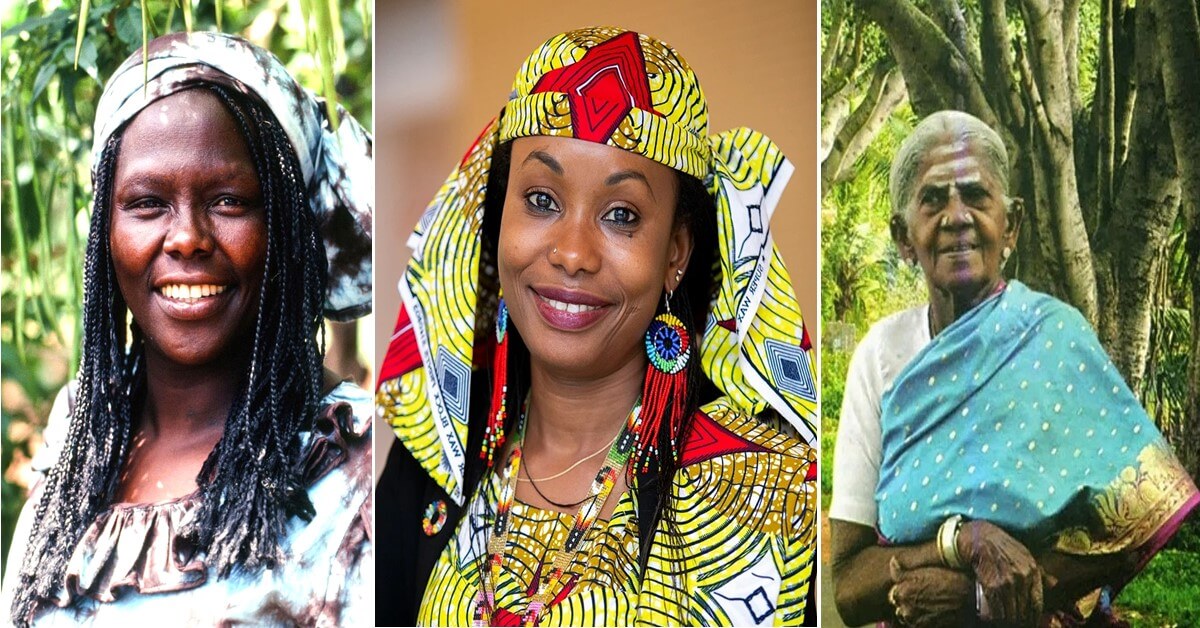Green heroes, the unsung champions of our planet, have long understood the profound impact that a single tree can have on our environment. In the face of climate change and deforestation, these inspiring individuals have emerged as beacons of hope, tirelessly dedicating their lives to the noble cause of planting trees.
Their remarkable stories echo far beyond the rustle of leaves and the scent of pine; they are narratives of resilience, determination, and unwavering commitment to nurturing our Earth back to health.
In the pages that follow, prepare to embark on a journey that unveils the extraordinary lives of these green heroes, illuminating the transformative power of their actions and the enduring legacy they leave behind.
Our environment is polluted in various dimensions. There is air pollution, plastic pollution, light pollution, water pollution, soil degradation, and deforestation all of which are responsible for the emission of CO2, and global warming.
Because of changed and unreliable weather patterns, living is getting difficult not only for humans but for animals as well. The food production cycle has been changed and the amount has been declining.
Fish population size is downsizing and poor and middle-class families in many parts of the world are forced to cut fish from their regular diet, let alone meat. We have to take care of our nature if we expect to live well, and are concerned about the well-being of future generations.
Sad Scenario of Forest
Trees, forests, woodlands, and wetlands are extremely important for Mother Earth for the survival of biodiversity. 31 per cent of total land contains nearly 3 trillion trees in 4.06 billion haters of forest land.
Forest biodiversity is not an ecosystem service per se but rather an essential ecological factor contributing to healthy forest functioning, and thus to the generation of ecosystem services.
Forests support the living of many people around the world. It is estimated that 750 million people live in forests, and 13.4 million people work in the forest sector.
Along with more than 2,000 indigenous groups around the globe, there are between 1 billion and 2.6 billion people who are dependent directly or indirectly for their livelihoods, medicine, fuel, food, and shelter in forests.
However, disturbances like wildfires, cyclones, droughts, floods, beetles, gypsy moths, fungi, viruses, and man-made disturbances like clear cuts, deforestation and pollution are responsible for forest decline.
Since 1990, an estimated 420 million ha of forest has been lost globally through deforestation. During 2015-2020, the annual forest loss rate was 10 million hectares.
However, according to the UN Global Forest Resources Assessment 2020, since 1990, the world has lost 178 hectares of forest land. Fortunately, the rate of net forest loss declined from 7.8 million hectares per year in the decade 1990–2000 to 5.2 million ha per year in 2000–2010 and 4.7 million hectares per year in 2010–2020.
Moreover, one-fifth or more than 2 billion hectares of the earth’s land area are degraded globally, risking the well-being of some 3.2 billion people, driving species to extinction and intensifying climate change.
Forst—boreal, temperature and tropical—together absorbed nearly 12 billion tons of CO2. The loss of forests negatively impacts the livelihood of people. Declining forests means increased carbon emissions, diminished biodiversity and the degradation of land.
We must maintain, preserve and conserve forests, plant trees and think green in order to halt global warming. Urban people’s suffering from hot weather becoming unbearable. Inadequate amount of vegetation and greenery is responsible for warmer urban weather where villages experience less hit.
Despite the concurrent trend of declining forest, deforestation there are many wonderful human beings who dedicated their lives to planting trees all over the world.
We are going get to know about the women who have championed tree planting and environmental conservation efforts around the world, including someone from Bangladesh.
Green Heroes
1. Wangari Maathai
Wangari Maathai was a renowned environmentalist and founder of the Green Belt Movement in 1977 in Kenya. She was awarded the Nobel Peace Prize in 2004 for her contribution to sustainable development, democracy, and peace through her tree-planting initiatives.
Through the Green Belt Movement, Wangari Maathai and her team encouraged rural women in Kenya to plant trees as a means of combating deforestation, soil erosion, and the negative impacts of environmental degradation.
Her efforts not only helped restore Kenya’s natural landscapes but also empowered countless women by providing them with economic opportunities and a stronger voice in their communities.
In recognition of her tireless dedication to environmental sustainability, democracy, and peace, Wangari Maathai was awarded the Nobel Peace Prize in 2004. She became the first African woman and the first environmentalist to receive this prestigious honour.
Wangari Maathai’s legacy continues to inspire individuals and organizations worldwide to take action in the fight against climate change and to promote the importance of sustainable environmental practices.
Her life’s work exemplifies the powerful impact that one person can have in creating positive change for the planet and its people.
2. Hindou Oumarou Ibrahim
Hindou Oumarou Ibrahim is an environmental activist from Chad who focuses on the intersection of indigenous knowledge and climate change. She is known for her work in preserving biodiversity and advocating for tree planting in indigenous communities.
She has dedicated her life to addressing the intersection of climate change, indigenous knowledge, and sustainable development, particularly in the context of indigenous communities.
Ibrahim is known for her tireless efforts to raise awareness about the challenges faced by indigenous peoples, especially those living in vulnerable and marginalized regions impacted by climate change.
She has been a strong advocate for the inclusion of indigenous knowledge and traditional practices in climate adaptation and mitigation strategies.
Her work has often centred on tree planting and land management practices that align with indigenous wisdom. By promoting sustainable agricultural techniques and the protection of natural resources, including trees and forests, she has contributed to both environmental conservation and the well-being of indigenous communities.
In addition to her environmental work, Hindou Oumarou Ibrahim has been an active participant in international climate conferences and negotiations. She has used her platform to amplify the voices of indigenous peoples and advocate for their rights within global climate policy discussions.
Ibrahim’s dedication to the environment, indigenous rights, and the fight against climate change has earned her recognition and respect on the global stage. Her work serves as an inspiring example of how individuals can make a meaningful impact on the world by advocating for environmental sustainability and the rights of indigenous communities.
3. Dr. Vandana Shiva
Dr. Vandana Shiva is an Indian environmental activist and scientist who has been at the forefront of the fight against deforestation and the promotion of sustainable agriculture. She emphasizes the importance of trees in maintaining ecological balance.
Dr. Vandana Shiva is an Indian environmental activist, author, and scholar known for her work in the fields of environmentalism, sustainable agriculture, and biodiversity conservation. She was born on November 5, 1952, in Dehradun, India.
Dr. Shiva has made significant contributions to the global environmental movement and is recognized as a prominent voice on issues related to food security, genetic engineering, and the protection of indigenous knowledge and traditional farming practices.
Environmental Activism: Dr. Shiva has been a staunch advocate for the protection of the environment and has campaigned against practices such as genetically modified organisms (GMOs), monoculture farming, and the privatization of seeds. She believes in the importance of sustainable agriculture and the preservation of traditional farming methods.
Biodiversity Conservation: She has emphasized the critical role of biodiversity in maintaining the health of ecosystems and ensuring food security. Her work has focused on the preservation of native seeds and the promotion of organic farming to protect biodiversity.
Navdanya: Dr. Shiva founded Navdanya, a non-governmental organization in India dedicated to the conservation of native seeds and promoting organic farming practices. Navdanya has worked to empower local farmers and promote food sovereignty.
Authorship: She has written numerous books on topics related to agriculture, environment, and sustainable development. Some of her notable works include “Stolen Harvest: The Hijacking of the Global Food Supply” and “Earth Democracy: Justice, Sustainability, and Peace.”
Awards and Recognition: Dr. Vandana Shiva has received several awards and honors for her environmental activism and advocacy for sustainable agriculture. These include the Right Livelihood Award (Alternative Nobel Prize) and the Sydney Peace Prize.
Advocacy for Women’s Rights: She has also been an advocate for women’s rights in the context of agriculture, emphasizing the crucial role of women in seed saving and farming, and the need for gender equality in agricultural practices.
Academic Background: Dr. Shiva holds a Ph.D. in Quantum Theory from the University of Western Ontario in Canada and has a strong educational and scientific background.
Vandana Shiva’s work and activism have had a significant impact on the global conversation surrounding sustainable agriculture, environmental conservation, and the protection of traditional knowledge and practices. She continues to be a prominent figure in the global environmental movement.
4. Yacouba Sawadogo
Yacouba Sawadogo, from Burkina Faso, is a farmer and environmentalist who has pioneered a technique called “zai” that involves planting trees alongside crop cultivation. His efforts have helped combat desertification in the region.
Yacouba Sawadogo is a Burkinabé farmer and environmentalist who is widely recognized for his innovative agricultural practices and his efforts to combat desertification in the Sahel region of West Africa. He has become known as the “Man who stopped the desert.” Here are some key points about Yacouba Sawadogo:
Agroforestry and Soil Conservation: Yacouba Sawadogo is known for his pioneering work in agroforestry and soil conservation. In an effort to combat soil erosion and desertification in Burkina Faso, he developed a technique called “zai,” which involves digging small pits in the ground and filling them with organic matter. This method helps to retain moisture, improve soil fertility, and promote the growth of crops, even in arid conditions.
Reforestation Efforts: Yacouba Sawadogo has been actively involved in reforestation efforts in his region. He has planted thousands of trees, including native species, to help restore vegetation and combat the encroachment of the desert.
Local Knowledge and Traditional Wisdom: Sawadogo’s work is rooted in the use of traditional knowledge and practices that have been passed down through generations. He emphasizes the importance of indigenous wisdom in addressing environmental challenges.
Recognition and Awards: Yacouba Sawadogo’s contributions to sustainable agriculture and desertification control have earned him international recognition. He received the Right Livelihood Award (Alternative Nobel Prize) in 2018 for his dedication and success in rehabilitating degraded land and improving food security in the Sahel.
Inspiration and Education: Sawadogo’s work has inspired farmers and conservationists in the Sahel and beyond. He actively shares his knowledge and experiences with local communities and international organizations to promote sustainable land management practices.
Documentary Films: Several documentary films have been made about Yacouba Sawadogo’s life and work, bringing attention to his remarkable efforts to combat desertification and promote sustainable agriculture.
Yacouba Sawadogo’s work serves as a powerful example of how innovative and sustainable farming practices, combined with the preservation of traditional knowledge, can help combat desertification and improve food security in regions facing severe environmental challenges. His dedication and success have made him a symbol of hope and resilience in the fight against desertification in West Africa.
5. Diana Beresford-Kroeger:
Diana Beresford-Kroeger, a botanist and author, has dedicated her life to promoting the importance of trees and forests. She has written extensively about the ecological and medicinal properties of trees and advocates for their protection.
Diana Beresford-Kroeger is a Canadian botanist, biochemist, author, and environmentalist known for her extensive work in promoting the importance of trees, forests, and biodiversity conservation. She was born on August 15, 1944, in Ireland and later became a Canadian citizen. Here are some key points about Diana Beresford-Kroeger:
Botanical Expertise: Diana Beresford-Kroeger has a deep understanding of trees, plants, and ecosystems. Her scientific background includes training in botany, biochemistry, and horticulture.
Forest Advocacy: She is a passionate advocate for the preservation of forests and the crucial role they play in mitigating climate change, maintaining biodiversity, and sustaining life on Earth. Her work emphasizes the importance of reforestation and protecting native tree species.
Traditional Ecological Knowledge: Beresford-Kroeger values and incorporates traditional ecological knowledge into her work. She has a profound respect for Indigenous wisdom and has collaborated with Indigenous communities on environmental and conservation initiatives.
Documentary Film: A documentary film titled “Call of the Forest: The Forgotten Wisdom of Trees” was produced based on her work and advocacy. The film highlights the importance of trees and forests in addressing environmental challenges.
Tree Planting Initiatives: She has been involved in various tree planting initiatives and campaigns to raise awareness about the critical role of trees in combating climate change and restoring ecosystems.
Honours and Awards: Diana Beresford-Kroeger has received numerous awards and honours for her environmental work, including being appointed a Member of the Order of Canada in recognition of her contributions to forestry and conservation.
Educational Efforts: Beresford-Kroeger is actively involved in educating the public, policymakers, and students about the importance of trees and ecological conservation. She believes in the power of knowledge and advocacy to drive positive change.
Diana Beresford-Kroeger’s work emphasizes the need for a holistic and science-based approach to address environmental challenges, with a strong focus on the preservation of forests and the importance of trees in maintaining the health of our planet. She continues to be a prominent voice in the global environmental movement, advocating for a deeper connection between humanity and the natural world.
6. Saalumarada Thimmakka
Saalumarada Thimmakka, also known as Thimmakka, is an Indian environmentalist and social activist known for her extraordinary efforts in tree planting and conservation.
She hails from Karnataka, India, and her inspiring story has earned her national and international recognition. Here are some key points about Saalumarada Thimmakka:
Tree Planting: Thimmakka is famous for planting and nurturing hundreds of banyan trees (Ficus benghalensis) along a 4-kilometer stretch of highway between Hulikal and Kudoor in the Indian state of Karnataka.
She and her husband, Chikkaiah, began this work in the 1950s when they were unable to have children. Instead, they dedicated their lives to planting and caring for trees.
Environmental Stewardship: Through her tireless efforts, Thimmakka has not only contributed significantly to reforestation but has also raised awareness about the importance of trees in environmental conservation and carbon sequestration. Her story serves as an inspiration for environmentalists worldwide.
Recognition and Awards: Thimmakka’s remarkable work has received widespread recognition. She has received several awards and honours, including the National Citizens’ Award of India in 1996 and the Padma Shri, one of India’s highest civilian honours, in 2019.
Educational Efforts: Thimmakka has used her recognition to advocate for environmental education and awareness. She believes in the power of education to inspire future generations to care for the environment.
Legacy: The trees planted by Thimmakka continue to provide shade and benefit the local ecosystem. Her story has also inspired others to take up tree planting and conservation efforts.
Documentary and Biographical Works: Thimmakka’s life and contributions have been documented in various forms, including books, documentaries, and articles, to inspire people around the world.
Saalumarada Thimmakka’s dedication to tree planting and environmental conservation has made her a symbol of grassroots environmentalism and a source of inspiration for individuals and organizations working to protect and restore the natural world.
Her legacy serves as a reminder of the impact that one person’s dedication and love for the environment can have on the planet.
These women have made significant contributions to tree planting and environmental conservation, inspiring others to take action and protect our planet for future generations.
7. Khurshida Begum
A young widow, Khurshida Begum is a Bangladeshi nature conservationist who advocated the necessity of trees and stopped logging in the communities in the southern part of the country.
Her effort to preserve and protect nature and natural resources awarded her with the Wangari Maathai Award in 2012.
In the vast tapestry of environmental conservation, there exists a special thread woven by remarkable women who have dedicated their lives to planting trees. Their stories are not just about cultivating greenery; they are narratives of resilience, passion, and unwavering commitment to Mother Earth. These women have shown the world that the act of planting a single tree can give rise to a forest of change.
8. Julia Butterfly Hill
Known as the guardian of the Redwoods, Julia Butterfly Hill captured the world’s attention when she spent 738 days living in a 200-foot-tall California redwood tree named “Luna” in the late 1990s. Her tree-sit was a peaceful protest against logging, and it ultimately led to the preservation of Luna and surrounding trees. Julia’s unwavering dedication demonstrated the power of one person’s commitment to preserving ancient forests.
9. Jadav Payeng
The Indian environmentalist and a forestry worker from Majuli River Island of Brahmaputra River in Assam has come to be known as the Forest Man of India for turning the sandbar of the river into a forest reserve.
He planted trees on an area of 550 hectares for which he was honoured with the Padma Shri award, the fourth-highest-civilian honour in India, in 2015. Payeng is a member of the Miri tribe of Assam.
When 16 in 1979, he witnessed many snakes die due to excessive hit and that washed up to the bare and tree-less sandbar of Majuli Reserve of the River Brahmaputra and the world’s largest island, that he was greatly hurt and began planting bamboo. From his sense of responsibility to do something for the wild lives he started planting a tree everyday tree, an afford for which Payeng came to be known as the Forest Man of India.
The formerly desolate sandy area then turned into a safe haven for wild animals like the Bengal tiger, Indian rhinoceros, elephants, deer, rabbits and birds. Though Payeng sells milk to run his family, he always returns to his trees and keeps planting one every day.
His simple and nature-dependent yet benevolent life attracted my people who created fictional films, documentaries and the subject of children’s books like The Boy Who Grew A Forest: The True Story of Jadav Payeng by Sophia Gholz and Jadav and the Tree-Place by Vinayak Varma for his extraordinary courage and afford to save, preserve and conserve the environmental beauty.
These remarkable men and women, from different corners of the world, share a common passion for the Earth and a belief in the transformative power of planting trees.
Moreover, in addition to my favourite naturalist Sir David Attenborough who dedicated his entire life to the beauty of nature and promoting the preservation of nature, there are people like environmentalists Greta Thunberg, Jane Goodall, Wangari Tharao, Paul Watson, Isatou Ceesay, Jacques Cousteau, and Theo Quenee are regularly and consistently raising voices to promote and protect wildlife and against global warming.
Their stories remind us that we all have a role to play in protecting our planet and that even the smallest actions can make a significant difference. They are living testaments to the idea that the roots of inspiration run deep, and they continue to inspire countless others to plant the seeds of change for a greener, more sustainable world.
In the quiet embrace of nature, amidst the rustle of leaves and the melody of birdsong, there exists a profound legacy woven by remarkable women.
These unsung heroines have devoted their lives to a cause that stretches far beyond the confines of their communities; they have planted seeds of change, both metaphorically and literally. Rooted in inspiration, these women have emerged as guardians of our planet, sowing the seeds of a greener future one tree at a time.
In every corner of the world, there are stories of resilience and determination, where women have defied societal norms and stood tall as guardians of the environment. Their hands, calloused from the earth they have tirelessly tended, tell tales of dedication. Their eyes, gleaming with hope, envision a world where lush forests breathe life into the very essence of our existence.
These women, armed with nothing but sheer determination, have transformed barren lands into thriving ecosystems. Their initiatives have not only revitalized the soil but also the spirit of their communities. They understand, perhaps better than anyone, that planting trees isn’t merely an environmental endeavour; it is an act of nurturing hope, a testament to the power of collective action, and a demonstration of unwavering faith in a sustainable tomorrow.
As we celebrate these women and their extraordinary contributions, we are reminded of the interconnectedness of all life forms. Their dedication to nurturing the earth echoes a profound truth – the health of our planet is intertwined with the empowerment of its people, particularly its women.
In the tapestry of environmental conservation, these women have woven threads of inspiration. They have taught us that every sapling we plant today carries the promise of a better future.
Their legacy challenges us to reassess our roles as stewards of the Earth. The torchbearers of this noble cause, these women serve as beacons of hope, illuminating a path toward a harmonious coexistence between humanity and nature.
Rooted in inspiration, these women have shown us that in the act of planting trees, we sow the seeds of a sustainable legacy.
Conclusion
Through their unwavering commitment, they have transformed desolate landscapes into flourishing ecosystems, proving that the Earth’s redemption lies in the hands of those who care enough to nurture it. Let their stories be a reminder that we, too, can make a difference – one tree at a time.
In order to tackle climate change and make the planet Earth liveable for future generations, we all must plant trees, and preserve and promote nature. The wonderful men and women mentioned here can be our inspirations in expanding our greenery.
I think every country should adopt a policy like the Philippines that “every citizen at least 10 years of age shall plant one tree every month for five consecutive years.”






